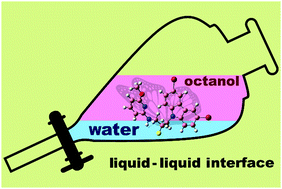Impact of the chemical structure on the distribution of neuroprotective N-alkyl-9H-carbazoles at octanol/water interfaces†
Abstract
All-atom molecular dynamics (MD) simulations were performed to systematically analyse the distribution and agglomeration of a series of small neuroprotective N-(3-anilinopropyl)-9H-carbazole based molecules at octanol/water interfaces along with a detailed assessment of their structural and dynamical properties, such as density profiles, distribution functions, average orientations, hydrogen bonding (H-bonding), and mean-square displacements. Our simulations show that the biologically active neuroprotective molecules easily migrate from the water phase to the octanol phase during the simulation trajectories. However, biologically inactive derivatives agglomerated in the water phase. Calculated radial distribution functions (RDFs) clearly underpin the necessity of the two 3,6-dibromo substituents on the carbazole core for a sufficient hydrophobic character. Furthermore, we could show that H-bonding from F, or OH groups located on the propyl unit with octanol or water molecules are decisive structural requirements for their distribution between the two liquid phases.



 Please wait while we load your content...
Please wait while we load your content...